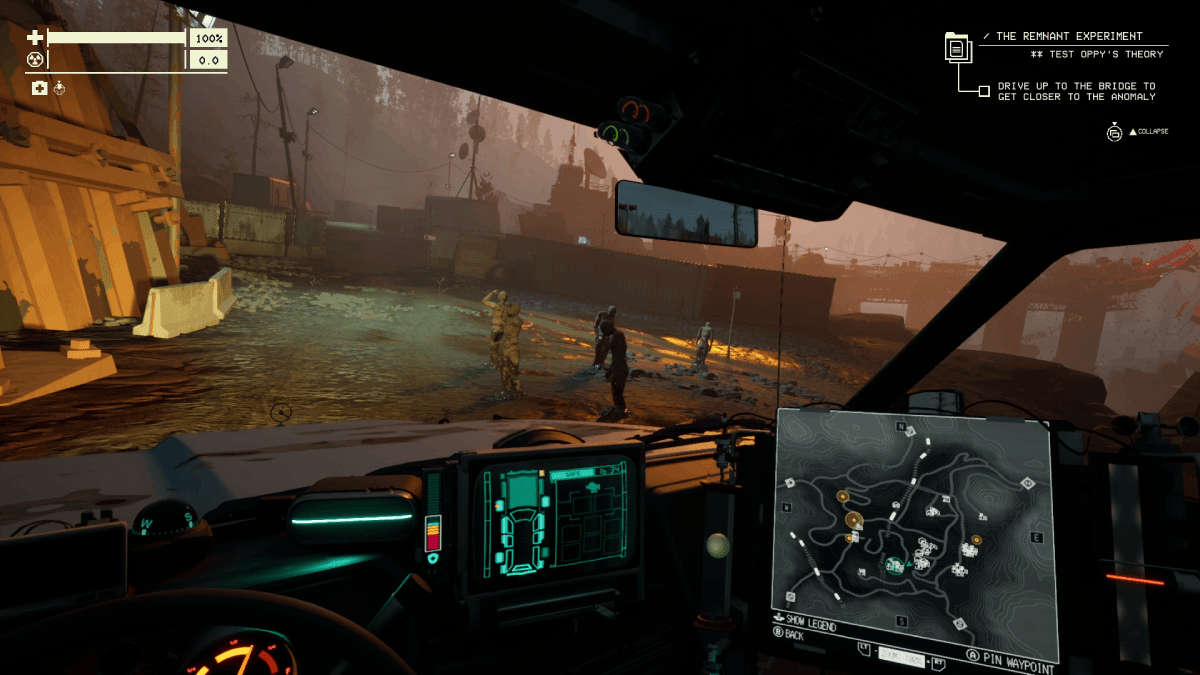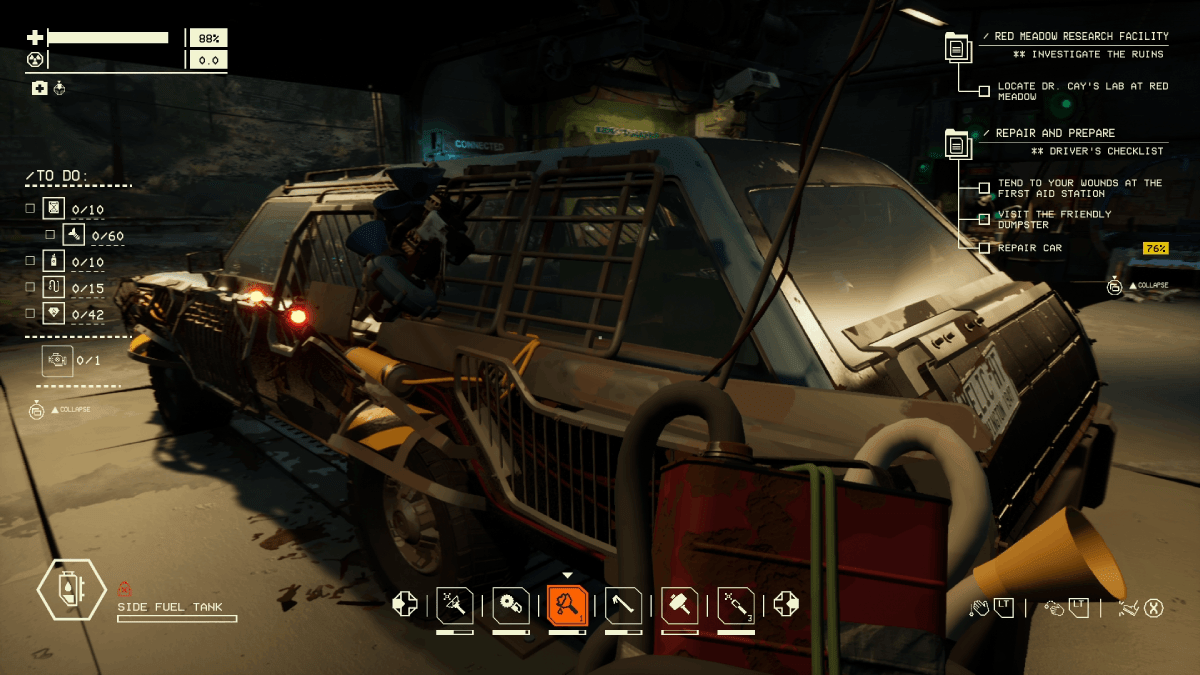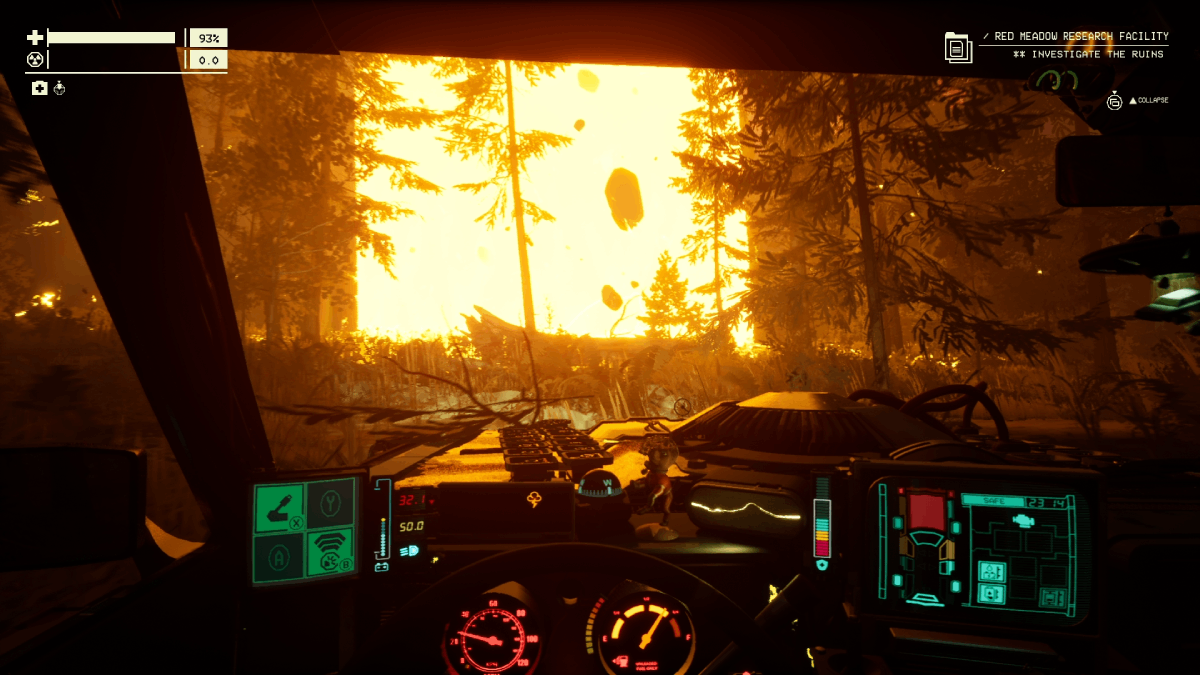Pacific Drive is a game that understands the joys of a road trip, like the open road, the freedom, and the adventure. However, this open road is one that’s determined to destroy you at every turn, so you better come prepared.
Pacific Drive has a simple premise. You play as a delivery driver who finds themselves sucked into a quarantine zone in the Pacific Northwest. Here, science went terribly wrong and unleashed a significant amount of instability on the area, causing reality to shift and warp. You need to get out, and the only help you have are three mysterious people on a radio and a car you commandeered upon entering the Zone.
This premise is wrapped around a survival roguelike driving game. If that feels like someone picked random genres out of a hat and then decided to make a game around it, it kind of is. However, Pacific Drive manages to make all these disparate elements work together in a way that managed to win me over, despite my general skepticism of at least two of those three elements.

Pacific Drive is best thought of as a game of two halves. In the first half, you are pushing your way through the deadly Olympic Exclusion Zone, trying to survive as best you can. In the second half, you are meticulously caring for your vehicle like a dad who bought a 1950s muscle car.
Let’s talk about the survival aspect. Your goal is to venture deeper into the Exclusion Zone, seeking a way to escape. This is a harsh wilderness, an area that once housed small towns and research stations, now home to an environment that hates all human life. This is not a wilderness where you have to fear the wildlife, it’s the ground, the trees, and the atmosphere that is actively hunting you down.
Each journey you take through the Zone sees you traveling through a series of nodes, each one a different region. Due to the constantly warping reality, each region changes its layout whenever you visit, much like you’d see in any given roguelike. Along the way, you’ll find abandoned bits of civilization that can be raided for essential supplies. There are no signs of human life, as it is replaced only by the anomalies.
These anomalies come in many forms. Some are pockets of dangerous energy, such as domes of free-floating electricity or radiation. Others like to throw your car around, such as floating rocks that act like a mushroom from Mario Kart or pockets of anti-gravity that launch you into the sky. Others cause more direct damage, such as pillars of earth that violently punch out of the ground, gigantic saw blades tearing through the landscape, or machines that will drag you screaming into the nearest tree.

Surviving all this is not easy. The only protection you have is your car, which is fragile at the best of times. It’s a standard family sedan with a look that suggests it was new around 1978. Its ignition is temperamental, the parking brake occasionally crunches, and its top speed varies depending on its mood. In its default state, its doors and panels feel like they’re made of paper and attached by wishes alone. It’s doing its best, but you are not getting out of an average run unscathed.
There’s a huge amount of tension in any given run of Pacific Drive. Heading into the Zone is a tense game of resource management, careful handling and balancing risk and reward. There is a pitch perfect atmosphere, where I constantly rushed around in a panicked state while out of the car. Everything feels like a calculated risk, where you’re constantly doing micro-calculations of whether to stay in an area and gather supplies or get out as quickly as possible.
Even heading back to safety is a risky game. The only way to return to your safe haven, an Auto Shop in a stable pocket, is to rip a hole in reality. You have to collect balls of energy, known as anchors, within the Zone, then use this energy to open a Gateway that leads you out. Problem is, this also summons a Fortnite-style storm that rapidly encloses the entire area, so you have to gun it to the exit before you’re eaten by a wall of red. It’s a tense moment but one that feels extremely satisfying when you hit that scary light pillar.

This is where the second half of the game comes in. When you limp back into the Auto Shop, you now have the opportunity to improve your car using whatever supplies you were able to scavenge. Although usually you first have to replace a few wheels and charge the battery because your headlights died on you at the last minute.
Something beautiful happens in this moment though. Hanging around the Auto Shop, crafting new parts and inspecting the car for any sudden faults is a weirdly meditative experience. The tension of the rest of the game drops away and you’re able to plan out your next moves. It becomes a strategy and management game, as you figure out how to improve your car while planning your next route. Do I need to do a resource run next, or do I want to push further into the Zone and continue the story?
Early in the story of Pacific Drive, your unseen radio helpers discuss the nature of the car as a Remnant, a supernatural object that causes its owner to become obsessed with it. Weirdly, this bled from lore into gameplay. I became incredibly attached to my car, much like the assorted bits of scrap I was strapping to the doors so it could absorb lightning strikes better. When its battery started draining, I was worried about it like a sick child. I felt like I was giving it a rewarding treat every time I gave it a new upgrade. I have enjoyed plenty of driving games in my life, but none of them have done this good a job of making me deeply care for a vehicle.

Despite all this, Pacific Drive is a bit messy. It is often frustrating in ways that feel unfair. The random nature of its environments mean you’ll often end up in maps where escape is hindered by a gauntlet of mountains. Progress can sometimes be stalled simply because the materials you need for certain components are refusing to spawn. Some of the anomalies are annoying rather than challenging or frightening – I’m looking at you, Bunnies. Finally, as you delve deeper into the Mid Zone and Deep Zone, some of the environments are just downright mean. None of this is enough to completely ruin the experience but it did make the game feel a little unbalanced at times.
Pacific Drive is a weird game. If you want to be swept into story of science gone horribly wrong, enjoy unique twists on the survival genre or have the capacity to fall in love with a car, there’s something here for you. However, its randomness and weird difficulty spikes are likely to be off-putting for others.
Pacific Drive is out now on PS5 and PC.
Pacific Drive is a first-person driving survival game with your car as your only companion.
Navigate a surreal reimagining of the Pacific Northwest, and face supernatural dangers as you venture into the Olympic Exclusion Zone.
Each excursion into the wilderness brings unique and strange challenges as you restore and upgrade your car from an abandoned garage that acts as your home base.
Gather precious resources and investigate what’s been left behind in the Zone; unravel a long-forgotten mystery while learning exactly what it takes to survive in this unpredictable, hostile environment. PC version reviewed. Review copy provided by company for testing purposes.
Pacific Drive is a unique twist on the survival genre that will make you fall in with a car, if you can handle its random difficulty spikes.
- Realism reaches new heights when you can bonk your head on your trunk door and take a single point of damage. So silly but I love it.
- If you find mannequins creepy, the Tourists will not help, as they may or may not be sentient and their motives are unclear.
- For the rare moments where you can cruise along happily, the in-game radio full of licensed music is an excellent addition.

